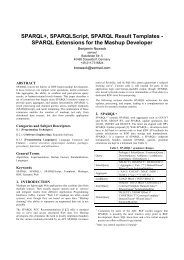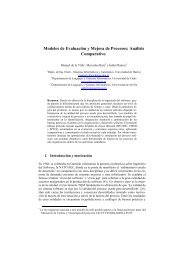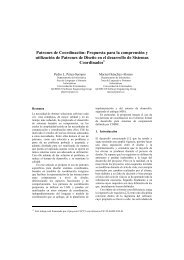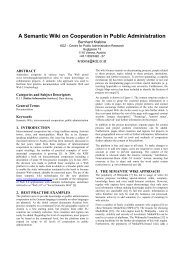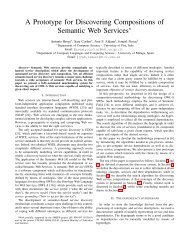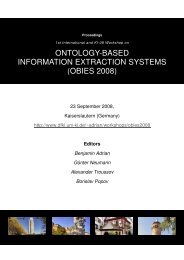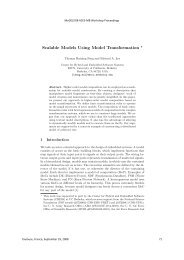Sim-Filter: User Profile based Smart Information Filtering and - FTP
Sim-Filter: User Profile based Smart Information Filtering and - FTP
Sim-Filter: User Profile based Smart Information Filtering and - FTP
Create successful ePaper yourself
Turn your PDF publications into a flip-book with our unique Google optimized e-Paper software.
<strong>and</strong> user profile building <strong>and</strong> implementation in smartcard. We describe our Internet<br />
<strong>based</strong> filtering system architecture <strong>and</strong> present an execution scenario in Section 4. We<br />
conclude <strong>and</strong> present our future work in Section 6.<br />
2 Related Works<br />
A filtering is crucial task in information delivering to users. <strong>User</strong>’s needs are modeled<br />
by his profile. Many works have been done on information filtering <strong>and</strong> many<br />
techniques have been proposed. This section presents some related works on<br />
information filtering <strong>and</strong> user profile modeling.<br />
2.1 <strong>Information</strong> <strong>Filter</strong>ing<br />
Belkin <strong>and</strong> Croft mention in [3] that information filtering describes a variety of<br />
processes involving the delivery of information to people who need it. Although, this<br />
term is appearing quite often in popular <strong>and</strong> technical articles describing applications<br />
such as electronic mail, multimedia distributed systems, news services systems <strong>and</strong><br />
digital libraries. <strong>Filter</strong>ing applications typically involve streams of incoming data,<br />
either being broadcast by remote sources such as news servers, or sent directly by<br />
other sources such as E-mail. <strong>Filter</strong>ing concerns also the process of accessing <strong>and</strong><br />
retrieving information from remote databases, in which case the incoming data is the<br />
result of the database requests.<br />
<strong>Information</strong> filtering systems are <strong>based</strong> on description of individual or group<br />
information preferences, often called profiles. Such profiles typically represent longterm<br />
interests of the user or community of users. The filtering process is often meant<br />
to imply the removal of data from an incoming stream, rather than finding data in<br />
that stream. In the first case, the users see what is left after the data is removed; in the<br />
latter case, they see what is extracted after the data is found. A common example of<br />
the first approach is an electronic mail filter designed to remove “junk” mails.<br />
Whereas, in the second approach, an example is to find only mail coming from a<br />
particular “diffusion list”. This means that profiles may not only express what users<br />
want, but also what they do not want.<br />
There are different filtering techniques referred in several research papers such as<br />
Boolean filtering [4], vector space techniques [5],[6],[7],[8],[4], probabilistic filtering<br />
[7],[9], linguistic <strong>and</strong> learning filtering techniques (neural networks, Case-Based<br />
Reasoning, genetic algorithms, etc.) [1],[11],[12],[13],[14], <strong>and</strong> [15].<br />
2.2 <strong>User</strong> <strong>Profile</strong> Modeling<br />
The Platform for Privacy Preferences Project (P3P), developed by the World Wide<br />
Web Consortium (W3C), determines a global architecture to preserve confidentiality<br />
on the Web [16]. This architecture offers secured profile exchange between a<br />
customer <strong>and</strong> a server. The goal of P3P is twofold. First, it allows Web sites to present<br />
their data-collection practices in a st<strong>and</strong>ardized, machine-readable, easy-to-locate



